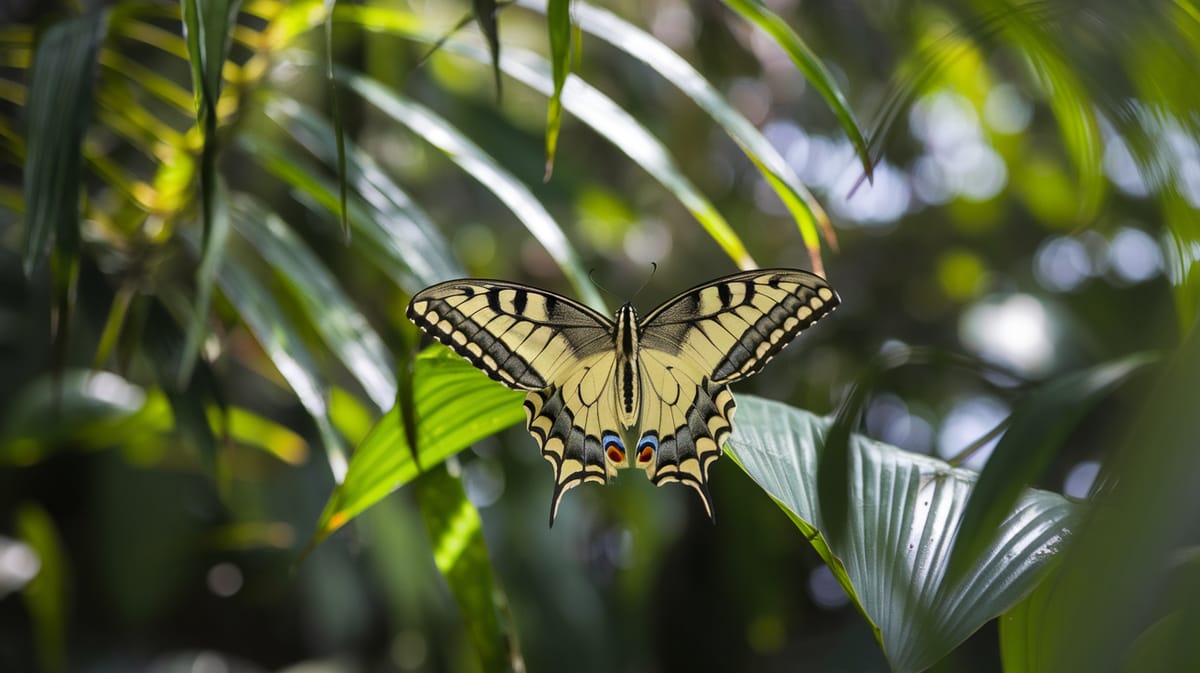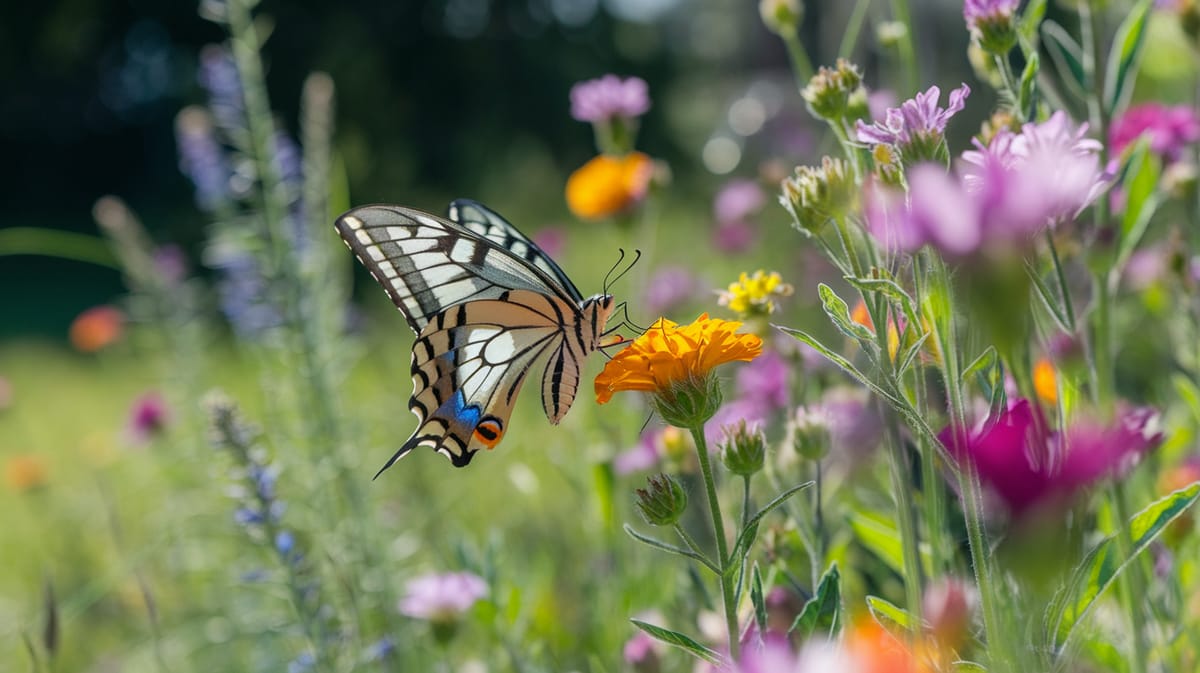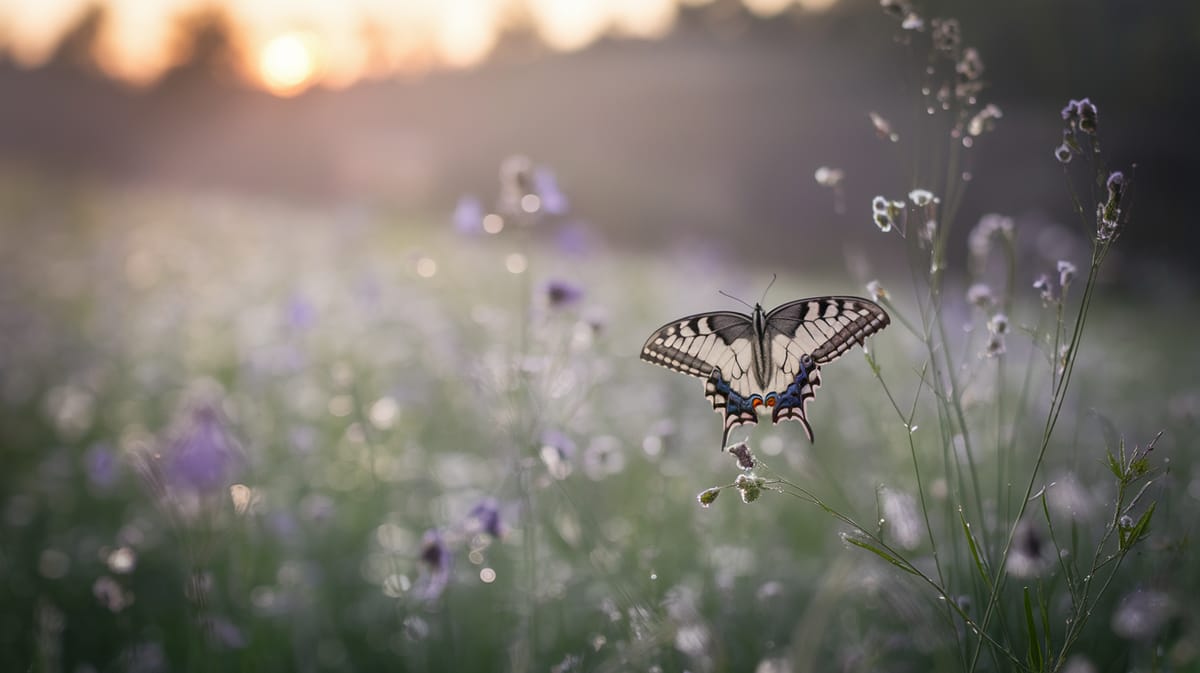Swallowtail Butterfly
Dancing through gardens, the Swallowtail Butterfly captivates with its vibrant colors and graceful flight. As a crucial pollinator, it contributes significantly to ecosystem health.

Key Insights at a Glance
Did You Know?
Taxonomy & Classification
Swallowtail butterflies are known for their vibrant colors and distinctive tail-like extensions on their hindwings, reflecting their adaptation to diverse habitats. Let's understand the evolutionary journey and classification of these remarkable pollinators.
Global Presence
Swallowtails boast around 550 species across the globe, adapting to varied environments from tropical rainforests to temperate zones.
Evolutionary Resilience
Originating in the Eocene, these butterflies have survived climate shifts and continue to thrive through their adaptive wing patterns and mimicry.
Lifecycle and Growth
A remarkable journey of transformation from Egg to Adult.
Egg
Swallowtail butterfly eggs are laid on host plant leaves, developing under protective shells before hatching into caterpillars.
Larva
The caterpillar feeds voraciously, molting multiple times as it grows rapidly, storing energy for its next stage.
Pupa
Enclosed in a chrysalis, transformation occurs as tissues reorganize to form adult structures.
Adult
Butterflies emerge with vibrant wings, focusing on nectar feeding and reproduction to continue their lifecycle.
Dietary Habits
Graceful pollinators with specialized feeding habits, these butterflies rely on floral nectar, occasionally supplementing with other plant-based nutrients.
| DIET TYPE | DESCRIPTION |
|---|---|
| Primary Diet | Primarily feeds on nectar from flowers like milkweed, phlox, and thistle using its long proboscis. |
| Secondary Diet | Consumes mineral-rich substances from damp soil or mud puddles, aiding in nutrient intake. |
| Occasional | Occasionally ingests sap, rotting fruit, or bird droppings to supplement diet, especially when nectar is scarce. |

Behaviour and Adaptations
Discover the fascinating adaptations of the Swallowtail Butterfly, showcasing their specialized survival tactics and evolutionary skills.
Wing Mimicry
Wing patterns mimic toxic species, deterring predators effectively.
Tail Decoy
Tail-like extensions distract predators from vital body parts.
Feeding Flexibility
Larvae feed on a variety of host plants for survival.
Ecosystem Impact
Swallowtail Butterflies play a vital role in ecological balance and biodiversity.
Pollination Partner
Facilitates cross-pollination, aiding in plant reproduction and diversity.
Food Chain Component
Serves as prey for birds and other predators, supporting food web dynamics.
Biodiversity Indicator
Indicates ecosystem health through population presence and diversity.
Conservation Challenges
Understanding and addressing the major threats to Swallowtail Butterfly populations.
Habitat Loss
Urbanization and agriculture reduce natural habitats for Swallowtail Butterflies.
Climate Change
Temperature shifts disrupt Swallowtail breeding and migration patterns.
Pesticide Use
Chemical pesticides harm Swallowtail larvae and adult populations.
Frequently Asked Questions
How long do Swallowtail Butterfly live?
Swallowtail butterflies typically live from a few weeks to a few months, depending on species and environmental conditions. Their life span includes stages such as egg, larva, pupa, and adult. The adult stage, where they are fully developed butterflies, usually lasts around two to four weeks.
What do Swallowtail Butterfly eat?
Swallowtail butterfly caterpillars primarily feed on host plants like dill, fennel, and parsley. Adult swallowtails consume nectar from a variety of flowers, including milkweed, thistle, and clover, providing them with the energy needed for flight and reproduction.
Are Swallowtail Butterfly poisonous?
While swallowtail butterflies themselves are not harmful, their caterpillars can be mildly toxic to predators due to their diet of host plants containing toxins. This provides them with a natural defense mechanism, deterring potential threats from eating them.
Are Swallowtail Butterfly endangered?
Most swallowtail butterfly species are not currently endangered, but some, like the Schaus' swallowtail, face threats from habitat loss and environmental changes. Conservation efforts are in place to protect these and other vulnerable butterfly species.
What do Swallowtail Butterfly symbolize?
Swallowtail butterflies often symbolize transformation, hope, and new beginnings due to their metamorphic life cycle. In various cultures, they are seen as symbols of beauty, grace, and the transient nature of life.
Do Swallowtail Butterfly bite?
Swallowtail butterflies do not bite. They do not have the mouthparts necessary for biting or chewing, as they primarily feed on nectar. They pose no threat to humans and are harmless creatures.
What color are Swallowtail Butterfly?
Swallowtail butterflies are known for their striking colors, often featuring patterns of yellow, black, blue, and orange. The specific coloration can vary widely among the different species, contributing to their visual appeal.
Does a Swallowtail Butterfly have wings?
Yes, swallowtail butterflies have wings. They are known for their large, colorful wings with distinctive tail-like extensions on their hindwings, which resemble the tails of swallows, a characteristic that gives them their name.
What does a Swallowtail Butterfly look like?
Swallowtail butterflies are large, vibrant butterflies with distinct, often colorful patterns on their wings. They typically have two extensions resembling tails on their hindwings, and their appearance can vary significantly across different species.
Is a Swallowtail Butterfly an insect?
Yes, a swallowtail butterfly is an insect. It belongs to the order Lepidoptera, characterized by its scale-covered wings, a four-stage life cycle, and a unique feeding structure called a proboscis for nectar consumption.
Related Insects
Discover insects with similar characteristics to Swallowtail Butterfly - including shared habitats, diets, and taxonomic classifications
Share this profile
Help others discover Swallowtail Butterfly
